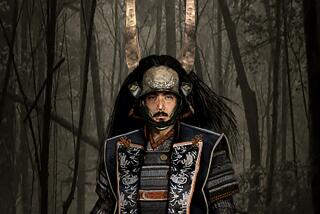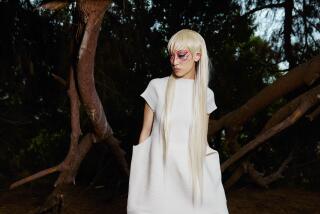CULTURE PEARLS : The Art of the Japanese Kimono
- Share via
It’s essentially little more than a V-neck gown, yet the kimono is acknowledged to be one of the world’s most exquisite garments. They’ve been worn in Japan since the 6th Century, but they blossomed with the decorative styles of 17th- and 18th-century artisans whose dyeing and weaving techniques continue today.
“The challenge for craftsmen now is to create kimonos that appeal to contemporary taste in an increasingly Westernized atmosphere,” said Sharon Takeda, assistant curator of costumes and textiles for Los Angeles County Museum of Art, which recently had an exhibition on kosode, predecessors of the kimono. “How do you keep this art alive when so many people are opting to wear Western dress, which is easier, less expensive and, for many, more comfortable?”
That question may be answered Friday through Sunday, when 31 kimonos by young artists from Kyoto, Japan, will be displayed at South Coast Plaza in Costa Mesa. It’s the largest-ever exhibition of contemporary Yuzen kimonos in the United States. The free exhibit is sponsored by the Japan External Trade Organization. Representatives of the Kyoto Art Dyeing Craftsmen’s Assn. and a translator will be on hand at the exhibit.
In Kyoto in the 1680s, fan painter Miyazaki Yuzensai began to decorate kimonos using dyes and fine lines of dye-resistant rice paste on white silk to produce intricate, multicolored designs remarkable for their brilliant hues and delicate outlines. Many kimono-making techniques have evolved from that initial process, known as Yuzen dyeing.
Such painstaking craft does not come cheap.
“While there are kimonos now being mass-produced,” Takeda pointed out, “the Japanese spend as much for a handmade Yuzen-dyed kimono as we’d pay for a car.” One kimono to be displayed, by Katsuhisa Miyajima, has been valued at $55,000.
Fan motifs and seasonal references continue to play a role in kimono design, but contemporary artisans are hoping to promote wider use of the kimono by using new motifs and using the old motifs in new ways. Kimonos, once universally worn by men and women in Japan, have for the most part been relegated to weddings, tea ceremonies and other formal occasions.
“Fewer and fewer kimonos are seen on the streets of Japan,” Takeda said. “Fewer and fewer Japanese women even know how to dress themselves in the kimono.
“It seems simple, but there is an art to putting on the kimono. When confronted with a formal occasion, many women will call a professional kimono dresser to come to the house and dress them properly.”
Takeda does not, however, believe that the kimono will disappear from Japanese culture.
“I can’t even conceive of it,” she said. “The numbers might dwindle in the face of the terrible recession in Japan, but the Japanese revere their traditional artisans much more than we do in the United States. . . . For many Japanese, (the kimono) is the essence of Japan.”
More to Read
The biggest entertainment stories
Get our big stories about Hollywood, film, television, music, arts, culture and more right in your inbox as soon as they publish.
You may occasionally receive promotional content from the Los Angeles Times.










